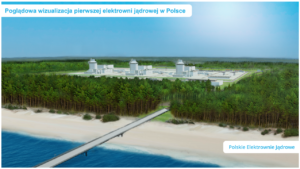Polish Minister of Climate and Environment has revealed PGNiG’s plan for contracting the Baltic Pipe. It should be adjusted for the Russian invasion of Ukraine – writes Wojciech Jakóbik, editor-in-chief at BiznesAlert.pl.
Construction of the Baltic Pipe, picture by Saipem
„PGNiG is able to extract 3 bcm on the Norwegian Shelf, plus a contract with Denmark’s Orsted for more than 6 billion cubic meters – this is the Baltic Pipe. There are no other contracts, there are business talks, most are very advanced,” said Climate Minister Anna Moskwa at the Senate quoted by the Polish News Agency. „Own extraction on the shelf is at 3 bcm, plus the big contract with Orsted for over 6 billion cubic meters. This is the Baltic Pipe. Of course, there are no other contracts. And that’s how it should be. This is in accordance with the schedule of negotiations, which PGNiG adopted,” the Minister explained. „There are a lot of business conversations, most of them are very advanced, and will be consistently concluded. We’re safe and sound this year. For the next year, we are sufficiently secured and we are concluding further contracts at the PGNiG level in business talks with large partners,” she added.
This information seems to confirm a thesis I proposed in May, when I argued that the Baltic Pipe should be contracted to the brim. The pipeline is expected to reach a capacity of 10 billion cubic meters by the end of the year. Initially, however, it is expected to pump 2-3 billion cubic meters per year, which matches what PGNiG produces on the Norwegian shelf. It is no accident that the contract with Orsted cited by the Minister is valid from the first of January 2023 to October 2028, giving a total of 6.4 billion cubic meters for five years, and therefore 1.28 billion cubic meters a year. Probably this is where the 5 bcm the Polish Prime Minister talked about as the level of Baltic Pipe’s contracting come from. However, the Minister’s statement suggests that by the end of the year it will be 3 billion cubic meters, which is in line with the available pipe capacity.
It can therefore be suspected, that PGNiG had a plan to contract additional supplies through the Baltic Pipe from January 2023, leaving room to finish the negotiations in the fall. Under normal market conditions, this would be a comfortable situation to finalize discussions with knowledge of current market indicators. It would allow gas to be contracted in the Baltic pipeline depending on needs, reduced for example by deliveries through the reverse on the Yamal pipeline from Germany, where Russian gas from Nord Stream 1 could come from. I have learned that even before February 2022, the option of buying from this direction was considered, which has been confirmed by the officials who spoke about purchases on the German exchange. This would mean that a new agreement or several, will be announced in September or later. Given the fact that PGNiG is to be taken over by PKN Orlen around October 2022, any news on this topic could be released by the management of the new merged entity. A package deal could be made where, for instance, Orlen-PGNiG would offer the Scandinavians cooperation on offshore wind farms. This is a popular strategy in Russia, which likes to bundle together different topics of negotiations, and perhaps the Northerners would be willing to follow suit.
However, Russia’s attack on Ukraine is a game changer. The reverse on the Yamal gas pipeline may not be available. The Ministry of Climate and Environment has reported that at this point this connection was not being used almost at all. „From the western direction in the connections that we have, in July and August, we have received enough gas to more or less cover daily demand. Given that the gas storage facilities are full, and the Baltic pipeline will be ready in the fall, the closure of the western direction will not affect the gas security of Poland at all,” assured Anna Moskwa at a press conference in response to a question from BiznesAlert.pl.
This means that the contracting of the Baltic pipeline should be maximized further, and the plan to finalize the contracts in the fall will be happening in a new reality, which is likely to increase the cost of contracts and reduce the availability of fossil fuels in the face of gas shortages in western Europe. So, the shopping will be expensive. That doesn’t mean we won’t be able to buy anything. The Prime Minister has assured that the capacity of the pipeline will be fully used in 2023. However, the atmosphere around the Baltic Pipe will deteriorate. The media have also speculated that an investigation commission may be set up to look into the purchases of gas for this pipe. The ceremony of launching it after many historical vicissitudes, scheduled for September 27, 2022, may therefore become an occasion for further political disputes that will undermine Poland’s success.









